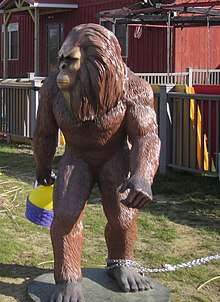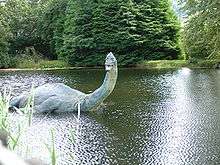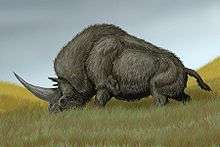Cryptozoology
Cryptobiology is the study of cryptids, creatures around which myths exist but whose current existence has never been verified. Some famous cryptids include bigfoot, the Loch Ness monster, and the chupacabra. Some cryptids are likely to remain only in the realm of fantasy and legend (e.g. the supposed nesting locations of dragons), whereas the existence of others have been confirmed biologically, often as "living fossils," e.g. the coelacanth and the giant squid.
Hominidae

Sightings of large ape-like creatures have been reported all over the world.
- Sasquatch (Bigfoot) has been long spoken of through Indian legends, and people still today claim to see these hairy man sized creatures all over North America, mostly in the Pacific Northwest
- The Yeti is another large ape like creature rumored to stalk the Himalayas, particularly in Tibet. In the Nepalese monastery of Khumjung, a scalp, believed to belong to a yeti and held sacred by the monks, exists.
- The Yowie is a similar creature of aboriginal legend that many people are convinced is roaming Australia, with the most sightings in Queensland
- The Loveland Frog is a manlike frog said to lurk near roads in Loveland, Ohio. May also be known by the name Loveland lizard.
- Wendigo. A mythical spirit or monster that eats men. Originates from native american folklore in the Northern United States and Canada.
Lake cryptids

- Loch Ness monster, affectionately known as Nessie, is probably the world's most famous lake monster.
- Storsjön (lit. Great Lake), in northern Sweden is said to be home to Storsjöodjuret (literally the Great Lake monster).
- Lake Van monster may or may not be related to the sea serpent myths of the Urartians, an Iron Age people who inhabited the area in far eastern Turkey. Highly sensationalized after a video that allegedly captured the monster was released in 1997, a lakeside town erected a statue of a dinosaur-like creature in its honour.
- The Brosno dragon or Brosnya is said to live in Lake Brosno near Andreapol (Tver Region) in Russia. Reportedly looking like a dragon or dinosaur, it has been the theme of local legends since the Mongol invasion of the 13th century.
- Ogopogo is said to live in Okanagan Lake in central British Columbia.
- Bessie (Lake Erie Monster). A creature in Lake Erie from Michigan folklore. The first sightings started in the 1790s, and sightings have been claimed in Toledo, Sandusky, and Cleveland
Extinct animals

- The Tasmanian Tiger (otherwise known as a Thylacine) went extinct in the early 20th century. However unconfirmed sightings have continued to this day in the remote north west of Tasmania and in Western Australia.
- Mokele-mbembe. A small dinosaur said to live in the Congo.
Animals outside their normal range
Encounters like these were actually more common a century ago in the UK when wild animals from elsewhere in the world were imported as pets and then just released into nature when the owners couldn't keep them or didn't want them any longer.
Big cats
There are a number of stories of large cats in southern England, the most notable being the Beast of Bodmin and the Beast of Exmoor.
Marsupials
- The Red-necked Wallabies of the Peak District
The little people
There are many European folklore stories about fairies, pixies, leprechaun and gnomes. The only visible sign you may find are fairy rings formed by dancing fairies as either a change in colour of grass in a ring shape of a few metres in diameter or if you are lucky a ring of mushrooms. (But in fact, these are formed by an expanding growth of fungi).
In Iceland, the huldufólk, mostly álfar, are taken seriously, with even road projects postponed or adjusted to account for places important for them. It should be easy to find a tour with this theme or at least a guide who will mention incidents.
If you keep your eyes open on day one of the Inca Trail, you may spot little dwellings said to belong to duendes.
Here be dragons
North America

- The snallygaster is a dragon-like creature said to reside in the mountains of western Frederick County, Maryland, near Braddock Heights. Reported sightings of the snallygaster go back for hundreds of years.
United Kingdom
- Lambton Worm, a dragon legend based around the river Wear near and the Penshaw Monument near Washington (England).
Flying Cryptids
- The Jersey Devil. A flying creature said to inhabit southern New Jersey.
- Mothman. A man with moth like wings said to live in Point Pleasant, West Virginia.
- Thunderbird. Could refer to a number of North American birds said to have large wingspans (Anywhere from 10 feet to 150 feet)
Unclassified
- The Chupacabra has the rather scary name of 'goat sucker', and has been often been described as reptile-like with many spines along its back. They have been reported throughout Latin America, although the original sighting was reported in Puerto Rico.
Stay safe
As these creatures are out of folklore, naturally there are no proven cases of injury, although given their supposedly secretive nature, who knows? Many of these legends are based in remote locations with sometimes hazardous weather conditions so care and preparation with food and equipment may be advisable, simply because of that. Also public access to private land varies greatly around the world, so check with the country and region article pages for details.